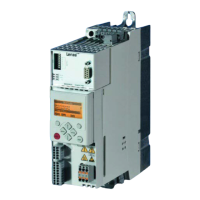8400 StateLine C | Reference manual
Motor control (MCTRL)
Parameterisable additional functions
202 L Firmware ≤ 11.00 - DMS 8.0 EN - 10/2011
4. Set the flying restart current in C00994.
We recommend setting a flying restart current of 10 % ... 25 % of the rated motor
current.
• During a flying restart process, a current is injected into the motor to identify
the speed.
• Reducing the current causes a reduction of the motor torque during the flying
restart process. A short-time starting action or reversing of the motor is
prevented with low flying restart currents.
• An increase of the current improves the robustness of the flying restart
function.
Tip!
Use of motors with higher rated frequencies
For trouble-free operation, we recommend to manually enter a starting frequency
of 20 % of the rated motor frequency in C00992
as well as to accelerate the flying
restart process (see above) and to use a lower flying restart current (10 % of the
rated motor current) if motors with higher rated frequencies are used.
Optimisation of the flying restart time
From version 05.00.00, the duration of the flying restart process can be influenced
via the setting of the integration time (C00993
). A reduction of the integration
time causes the flying restart function to accelerate and thus a reduced flying
restart time.
• We recommend not to change the Lenze setting of the integration time.
• When special motor are used (e.g. multi-pole motors or ASM servo motors), a
reduced integration time may improve the flying restart behaviour.
Optimising the current controller if the behaviour is unstable
During the execution of flying restart function, peak currents/torques are avoided
by controlling the current amplitude.
Gain (C00075
) and reset time (C00076) of the current controller can be adapted to
improve the jerk-free/torque-free connection of the inverter to the supply of the
rotating motor.
• We recommend not to change the Lenze setting of the current controller.
• If the behaviour of the current controller is unstable, gain and reset time can be
calculated as per the following formulae:
[5-18] Formulae for the calculation of the gain and reset time of the current controller
V
p
= Current controller gain (C00075)
T
i
= Current controller reset time (C00076)
L
ss
= Motor stator leakage inductance (C00085)
R
s
= Motor stator resistance (C00084)
T
E
= Equivalent time constant (= 500 μs)

